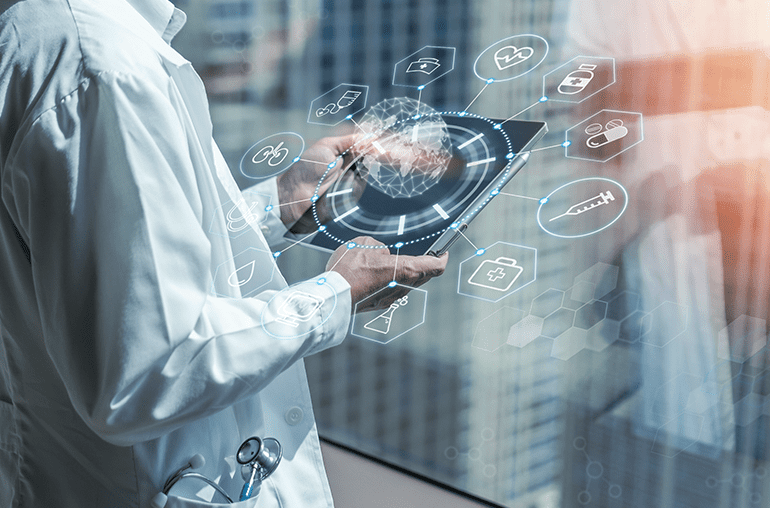
The Internet of Things (IoT) is revolutionizing healthcare delivery at every level. The benefits of IoT in healthcare are far-reaching, positively impacting patients, practitioners, healthcare organizations, and related industries such as cybersecurity and insurance. But what do these IoT telehealth solutions look like in the real world? Let’s look at some of the ways IoT in healthcare is transforming the telehealth landscape.
1. Remote Patient Monitoring
IoT healthcare devices have ushered in a new era of patient care beyond traditional clinical settings. For example, leveraging wearables, sensors, and home monitoring systems, patient data can now be collected remotely in real-time. IoT devices in healthcare empower physicians and other healthcare professionals (HCPs) to track multiple factors instantly, such as:
- Vital signs
- Activity levels
- Medication adherence
With the information from medical IoT devices on hand, you can increase overall health through preventative strategies, spot early warning signs before symptoms surface, and act quickly to address issues before conditions become more severe.
2. Remote Senior Care
With nearly 56 million adults aged 65 and older in the US, representing 16.8% of the total population, senior care is a growing concern. As we age, we often need more frequent health checks and face higher risks of age-related issues like hearing loss, elevated blood pressure, and vision problems. For seniors with limited mobility, IoT devices offer a lifeline through remote monitoring. With the integration of IoT in healthcare, doctors and healthcare professionals can use these tools to increase independence and safety, giving peace of mind to patients, healthcare providers, and families alike.
3. Emergency Alerts and Response
Connected IoT healthcare devices and sensors enable patients to instantly alert healthcare providers or EMS during medical emergencies. A wearable that monitors heart rate, blood sugar, a fall or oxygen levels can automatically notify both patient and provider when action is needed. This real-time communication can slash emergency response times, potentially saving lives and reducing the impact of health complications. Equipping mobile healthcare units and emergency vehicles with Starlink and mobile wireless ensures they remain connected to medical records, diagnostic tools, and communication systems in rural or underserved areas.
4. Medication Adherence
The widespread adoption of healthcare IoT has dramatically improved medication adherence through smart management systems. Connected pillboxes and medication dispensers can be programmed to remind patients to take their medications at the right time and with the correct dosage. These devices can also track medication usage, alerting patients and/or caregivers when doses are missed or mismanaged. By generating vital patient data on medication habits, these systems contribute to more comprehensive electronic health records, enabling healthcare providers to deliver high-quality care while potentially reducing long-term healthcare costs.
5. Support for Doctors
Connected telehealth medical IoT devices, like digital stethoscopes, otoscopes, and high-resolution cameras, let physicians examine patients remotely with in-person level accuracy. These IoT medical devices transmit real-time audio, visual, and diagnostic data for informed decisions and accurate diagnoses. IoT-enabled telehealth platforms also facilitate secure communication and collaboration among healthcare professionals, enhancing interdisciplinary care and enabling additional consultations and second opinions. In times when access to medical care can be challenging, healthcare systems that are empowered by IoT solutions can dramatically improve patient outcomes and enable remote patient care on a level not previously possible.
6. Streamlined Home Healthcare
Remote connectivity provided by Starlink allows healthcare providers to conduct virtual consultations and provide care to patients in remote regions without requiring physical infrastructure. Intelligent scheduling systems connect patients, caregivers, and healthcare providers via one streamlined platform, making home healthcare faster and easier by:
- Automating routine tasks like scheduling appointments
- Coordinating medication refills
- Optimizing routes to reduce travel time and maximize patient interaction
- Enhancing communication for more efficient and personalized care
7. Enhanced Chronic Disease Management
For patients with chronic conditions like diabetes or hypertension, IoT devices are powerful tools for health management. These devices track vital signs, blood glucose levels, and medication adherence, transmitting crucial data to healthcare providers. IoT connectivity in healthcare enables continuous patient monitoring, allowing doctors to adjust treatment plans in real-time. The results are significant: fewer hospital visits, improved long-term health outlooks, and more positive patient outcomes.
8. Improved Data Encryption & Security
IoT in healthcare projects and telehealth programs are designed to ensure 100% secure health data transmission. Robust encryption protocols protect sensitive health information as it moves between devices and systems. Unlike paper records, electronic IoT telehealth data is safeguarded from unauthorized access. Only authorized individuals can decrypt, view, and interact with the data, ensuring HIPAA compliance. For example, MetTel’s network security services feature next-generation firewalls and DDoS protection to protect all devices and prevent cyberattacks.
9. Transparent Insurance Underwriting
IoT-driven data enhances transparency between insurers and consumers, showcasing another significant impact of IoT in healthcare. Insurance companies can leverage this data to:
- Detect fraudulent claims more easily
- Effortlessly corroborate valid claims
- Enhance risk assessment and pricing processes for accurate, personalized underwriting
This data-driven approach streamlines insurance processes and promotes fairness and accuracy in healthcare coverage, potentially leading to more tailored and cost-effective insurance options for consumers.
10. Continued Scientific Advancement
The widespread use of IoT in healthcare drives innovation and expands possibilities, fostering ongoing scientific progress. Devices like hearables, wearables, and ingestible sensors offer opportunities to experiment with cutting-edge technologies, algorithms, and interventions. By empowering researchers to prototype and develop new IoT for healthcare solutions, we accelerate the innovation cycle. This leads directly to the deployment of novel healthcare devices, applications, and services, continuously improving patient care and medical capabilities.
IoT Connectivity for a Better Future
When it comes to IoT in healthcare, MetTel’s IoT Single SIM is an ideal solution to keep devices connected. It finds the strongest signal anywhere, tapping into 650+ carriers across 165+ countries. In North America devices are provided with multi-carrier redundancy with automatic carrier switching between AT&T, Verizon, T-Mobile, US Cellular, and CellularOne. This ubiquitous coverage [RC1] eliminates dead zones and disconnects, ensuring seamless, reliable, and secure connectivity. By converging all communications over one proprietary network, we enable the easy deployment and management of technology-driven IT services for healthcare.
With award-winning innovations and excellent customer care, we manage, maintain, and secure your communications needs end-to-end. Our solutions and powerful cloud-based platform boost productivity, reduce costs, and simplify operations. This enables HCPs to work smarter in their mission to provide superior patient care and drive more positive outcomes.


